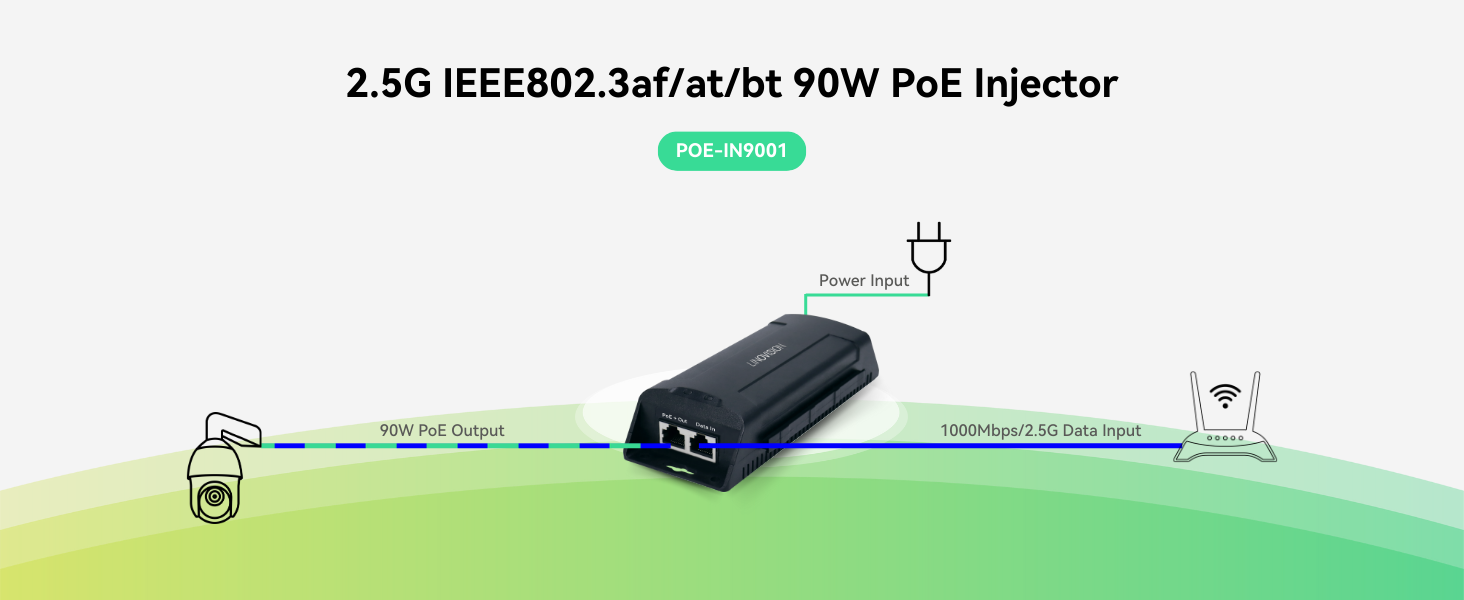Power over Ethernet (PoE) technology allows the transmission of power and data over Ethernet cabling, using devices such as PoE switches, PoE injectors, and PoE splitters. In situations where power outlets are not readily available, PoE injectors offer a convenient solution for installing low-power devices in hard-to-reach areas without significant infrastructure modifications or budget constraints. This article aims to provide a comprehensive understanding of PoE injectors, including their definition, usage in applications, and answers to frequently asked questions.
What is a PoE Injector?
A PoE injector, also known as a midspan or PoE adapter, enables non-PoE compatible switches to power PoE devices by delivering both power and data over a single Ethernet cable.
Benefits of PoE Injectors:
- Easy installation: Simply connect the PoE injector to the PoE endpoint and an Ethernet switch to provide data and power.
- Network expansion flexibility: PoE injectors add PoE capability to non-PoE Ethernet switches, extending the network connection distance and providing combined power and data over Ethernet cables for improved connectivity.
- Cost-effective solution: By utilizing existing Ethernet equipment and cabling infrastructure, implementing a PoE injector solution minimizes additional costs.
How Does a PoE Injector Work?

When Ethernet switches or other devices lack PoE functionality but need to support Powered Devices (PDs) like PoE IP cameras, PoE wireless access points (WAPs), or PoE lighting, a PoE injector can supply power and data to these PDs over distances of up to 100 meters. Typically, a PoE injector converts alternating current (AC) into direct current (DC) to power low-voltage PoE devices.
Types of PoE Injectors:
1.Active vs. Passive PoE Injector:

A PoE injector following the IEEE 802.3af, IEEE 802.3at, or IEEE 802.3bt standards is known as an active PoE injector. These injectors require a handshake between the power sending and receiving PoE devices. If the receiving device does not provide the proper acknowledgment, the injector will not supply power, ensuring the safety of PoE devices. Active PoE injectors generally operate at a voltage of 44 to 57 volts DC.
In contrast, a passive PoE injector does not conform to the IEEE standards mentioned above. Passive PoE devices usually operate at voltages ranging from 18 to 48 volts DC. Connecting the wrong voltage may cause permanent electrical damage to the device.
2.12V vs. 24V vs. 48V PoE Injector:
PoE injectors can be categorized based on the output power voltage they provide, such as 12V, 24V, or 48V. When selecting a PoE injector, it is crucial to consider the voltage requirements of the powered PoE devices.
Additionally, PoE injectors can also vary based on port numbers, such as single-port PoE injectors, 2-port PoE injectors, and so on.
How to Use a PoE Injector?
PoE injectors excel at providing data and power to standard-based PoE, PoE+, and PoE++ compliant devices. In practical applications, a PoE injector acts as an intermediary between a non-PoE switch and PoE compliant devices, such as IP cameras or wireless access points, delivering power to them.

Take an IP camera as an example. The following steps illustrate the power supply process:
- Test all equipment to ensure the IP camera, PoE injector, and camera management system are functioning properly. Configure video and network settings before mounting the IP camera.
- Connect the Ethernet cable from the PoE injector's Power or PoE port to the IP camera's PoE port.
- Mount the IP camera in a well-lit area to capture clear images.
- Connect another Ethernet cable between the injector's Ethernet or Data port and the Ethernet switch.
- Plug the injector's power cord into a local AC electrical outlet.

